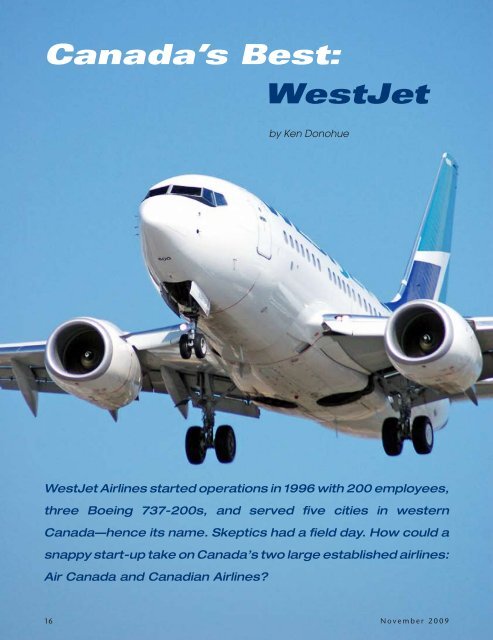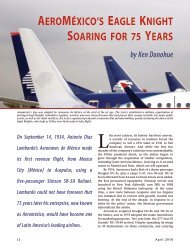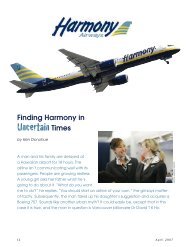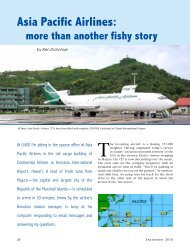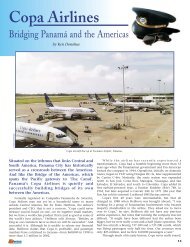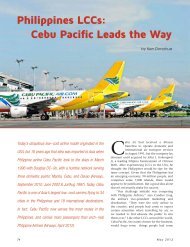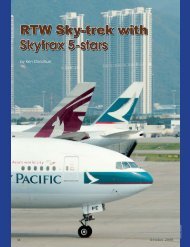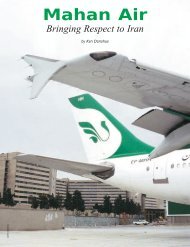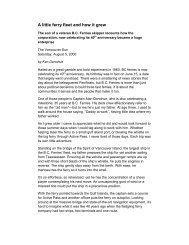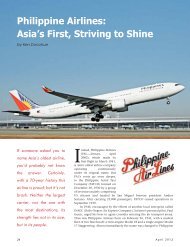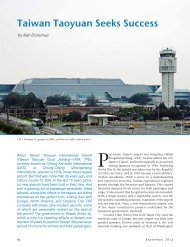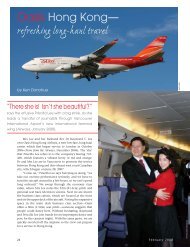Canada's Best: WestJet - Ken Donohue
Canada's Best: WestJet - Ken Donohue
Canada's Best: WestJet - Ken Donohue
Create successful ePaper yourself
Turn your PDF publications into a flip-book with our unique Google optimized e-Paper software.
Canada’s <strong>Best</strong>:<strong>WestJet</strong>by <strong>Ken</strong> <strong>Donohue</strong><strong>WestJet</strong> Airlines started operations in 1996 with 200 employees,three Boeing 737-200s, and served five cities in westernCanada—hence its name. Skeptics had a field day. How could asnappy start-up take on Canada’s two large established airlines:Air Canada and Canadian Airlines?16November 2009
BRIAN MCNAIR<strong>WestJet</strong> flies an average of 383 flights a day. The longest is 6hr 19min from Vancouver to Honolulu.the company that are bought by employees. <strong>WestJet</strong> evencapitalized on the notion of their staff as owners in asuccessful advertising campaign.“We want to align the interests of our employeeswith the business,” says Cummings. “And we supportour employees by budgeting a million dollars annuallyfor our Care Department to organize parties and otheremployee get-togethers.” Whether it’s a profit-sharingparty, or renting a movie theatre, or inviting families towash airplanes, <strong>WestJet</strong> believes in the old adage that ifyou look after your people, they’ll look after the business.Cummings admits that as the airline becomes bigger, it ismore difficult to pull everyone together as they could inthe early days.Following Air Canada’s takeover of Canadian in 2000,<strong>WestJet</strong> was presented with an opportunity to expandinto eastern Canada, and established a base in Hamilton,Ontario, approximately 40mi (65km) south of Toronto.True to the airline’s business model at the time, theairport in Hamilton was underserved, and while <strong>WestJet</strong>moved its eastern hub to Toronto’s Pearson InternationalAirport in 2004, Hamilton is still an important city on theairline’s network.“The move to Toronto was one of the biggest thingsthe airline agonized about,” recalls Cummings. “TheCanadian market is only so big, and if we were to developboth the leisure and business market, and continueFlight attendants Jaime Messina and Dana Strilkiwsky prepare asnack and beverage service. About 83% of <strong>WestJet</strong>ters own shares inthe company.JUAN HOUSTON18November 2009
JUAN HOUSTONgrowing, we needed to have a big presence there.” Thirtytwomillion passengers each year make Toronto thenation’s busiest airport, and exorbitant landing fees makeit one of the world’s most expensive—not somewhere thatlow-cost carriers would normally establish a hub. But theairline felt the benefits outweighed the cost, and Torontois now <strong>WestJet</strong>’s second-largest focus city, with more than70 flights a day.In 2004, <strong>WestJet</strong> made its foray into the US market, withflights to San Francisco, Los Angeles, Phoenix, Tampa, FortLauderdale, Orlando, and New York-LaGuardia. The latterwas dropped after less than a year, although the airlinenow serves Newark Liberty International Airport. “One ofthe challenging things in opening new routes is getting thegates and space we want,” says Cummings. “We’re now atthe size that we can negotiate with airports to get the timesthat work for us, but it still took us two years to get thetime we wanted at Newark.” In 2006, Nassau, Bahamas,became <strong>WestJet</strong>’s first destination outside Canada and theUSA. A year later, the airline pushed further south withflights to México, the Dominican Republic, and St Lucia.Cummings tells Airways that new areas of NorthAmerica are always a challenge, in the sense that the airlineneeds to understand and respect the local business culture.It’s often difficult to impart the unique <strong>WestJet</strong> style onsome of the contract staff and baggage handlers who workfor the airline in some of the destinations that have lessfrequent service. “We’re adapting our business model insome of these places,” says Cummings. “At some of ourbigger bases, such as Los Angeles and Orlando, we haveour own people, and we have been able to bring some ofour Mexican staff to our Calgary base for training.”<strong>WestJet</strong>’s network plan takes it to 2013, at which timeit expects to be operating 111 aircraft, and if everythinggoes as planned will increase its Canadian market shareto 45%. To get there, <strong>WestJet</strong> will increase capacity by50%, much of it dedicated to the Canadian market, witha couple of new destinations and increased frequencieson existing routes. “We are well positioned,” boastsCummings. “When we start a new route we are able tofill seats quickly. People have an affinity for <strong>WestJet</strong> andJUAN HOUSTONCaptain Steve Bulteel, who has been flying for <strong>WestJet</strong> for six years, ona preflight walkaround at Toronto. At the turn of the century <strong>WestJet</strong>had a 7% market share to Air Canada’s 77%. Today the score is<strong>WestJet</strong>: 36%; Air Canada: 57%appreciate the value we offer.” A study for <strong>WestJet</strong> byLeger Marketing, one of Canada’s most reputable researchcompanies, concluded that <strong>WestJet</strong> is Canada’s preferredairline, according to 49% of those asked during the survey;Air Canada was preferred by 35% of respondents.Cummings admits competition is good for everyone,because it forces companies to adapt and sharpen theirbusiness models. “A healthy market benefits everyone,”he says, in response to a question about Air Canada’sprecarious financial situation.While <strong>WestJet</strong> has been the darling of the Canadianairline industry, everything hasn’t gone the airline’s way.In 2004, <strong>WestJet</strong> was accused by Air Canada of espionage,when it reportedly accessed a private website more than200,000 times during a ten-month period and improperlygained access to Air Canada’s key flight operations data.This was undertaken with the knowledge and direction ofthe highest management levels of <strong>WestJet</strong>. The two-yearlegal battle ended in an out-of-court settlement when<strong>WestJet</strong> admitted to the charges, and paid C$5.5 million(then US$4.9 million) in legal and investigative fees to AirCanada and donated C$10 million (US$9.1 million) tocharity. A senior <strong>WestJet</strong> executive resigned over the issue.This incident was merely a blemish on the airline’sreputation. A more pressing concern, though onethat <strong>WestJet</strong> downplays, is the delay in a code-sharingAirways19
JUAN HOUSTONA 737-800 at Los Angeles. For the current winter schedule, <strong>WestJet</strong> has added 11 destinations and three new countries, plus many route pairingsbetween Canada and México.agreement with Southwest Airlines that was signed in2008, and was scheduled to be implemented by the endof 2009. “Southwest’s decision to delay implementationof the full code-sharing agreement is disappointing,but understandable in the current economic climate,”Cummings tells Airways. “We support Southwest’s decisionand look forward to resuming discussions with them whenthe time is right.”From a business perspective, the agreement withSouthwest will mean opportunities to share purchasing,ground handling, marketing, and selling to corporateaccounts. For <strong>WestJet</strong>’s customers it means access toSouthwest’s network of 65 cities in the USA. Likewise,Southwest passengers would have a comparable partnerfor destinations throughout Canada.Given the delay, <strong>WestJet</strong> is activating a code-shareagreement with the Air France-KLM Group. As part of thisinbound interline arrangement, Air France-KLM passengerscan connect to <strong>WestJet</strong>’s Canadian network. The airline alsohas a partnership with Hawai‘i’s Mokulele Airlines (Airways,November 2009), offering <strong>WestJet</strong> customers access to theHawaiian inter-island network. Cummings also hints thatmore such pacts are likely in the near future.Using its current model, <strong>WestJet</strong> is confident thatit will continue to see four to five more years of healthygrowth. The airline will soon begin charting an updatedlong-term strategy, and Cummings says that the idea ofintroducing a new aircraft type won’t be ruled out.<strong>WestJet</strong> has successfully tapped into demand fromunderserved airports. Abbotsford, 42mi (68km) east ofVancouver, is one of these. When <strong>WestJet</strong> started service tothis Fraser Valley airport in 1997, it was the first time in 20years that a scheduled jet carrier had started a totally newdestination in Canada. Before <strong>WestJet</strong> arrived, Abbotsfordwas known as an industrial airport that hosted Canada’slargest air show. Thanks to <strong>WestJet</strong>’s vision, the airportnow sees more than 500,000 passengers each year.Cummings explains that there are really threecategories of airports that <strong>WestJet</strong> serves. The firstcomprises the country’s large airports, such as Vancouver,Calgary, Toronto, and Montréal. Then there are thosesuch as Hamilton, Kitchener, and Abbotsford that havea significant population base, but that have traditionallybeen neglected. The third category of destinations—likeComox or Deer Lake, which have populations of less than20,000—would, on the surface, defy regular 737 service.“We are able to stimulate the local economies of some ofthese small communities,” says Cummings. “The logicmay suggest that these towns don’t have a critical mass,but we make it work by developing strong relationships.”<strong>WestJet</strong> has set a lofty goal for itself. Not content withsimply being Canada’s best airline, it strives to be one ofthe top five airlines in the world. “In 2006, we revisitedour vision statement and looked at the next ten years,”says Cummings. “We looked at our successes and what wecould become without losing the fabric and culture behindour success, and our ultimate goal is one of the top fiveinternational airlines.”While it is easy to say that you would like to be oneof the top airlines in the world, what does that mean andwhat would it look like? <strong>WestJet</strong> set about developing aninternal scorecard with three categories—business results,people and guests, and completion—to help the airlineachieve its goal. The first category is about profit margin,and while there is a lot of volatility in this, according to<strong>WestJet</strong> it has been in the top four for the past two years.20November 2009
Cummings admits that the second category is difficult tomeasure, while noting that the company has looked atmethods from around the world. The airline’s completionrate—not canceling flights, on-time performance, anddelivering baggage to passengers within 15 minutes ofarrival—rounds out the scorecard. “We’ll never be thelargest airline in the world, but we feel we can be one ofthe best airlines in the world,” asserts Cummings.Historically, <strong>WestJet</strong> has eschewed the trappings oftraditional air carriers, but is poised to introduce its ownfrequent flyer program early in 2010. “We have peoplethat fly with us six and ten times a year, but we don’t havea rewards program,” explains Cummings. “Ours will bedifferent than others, based on dollar spend.”<strong>WestJet</strong> prides itself on its customer service, which toits credit is better than most airlines. Sometimes it’s thelittle things that make the difference between an averageairline and a good one. For example, on a recent flightwith my family, the check-in agent noticed that we weretravelling with two young children, so she blocked offan entire row of six seats for us. With all of the airline’saccolades, often forgotten is that <strong>WestJet</strong> is still a LCC.While passengers are offered a complimentary soft drinkand package of cookies, the airline has a modest buy-onboardprogram. This was never a big issue when the airlinewas flying short stages, but as it expands across Canada, toHawai‘i, and into the Caribbean, passengers are spendingmore hours onboard. To be fair, however, most airlines inNorth America have lowered their product levels to thelow-cost model, doing away with meal service on manyroutes. <strong>WestJet</strong> offers 24 channels of seat-back satelliteTV on each of its single-class 737s, along with pay-perviewtelevision programming and movies. There are somelimitations to the satellite TV because the signal is lost overlarge stretches of ocean.Although <strong>WestJet</strong>’s low-cost model allows it toweather economic storms better than some airlines, it isnot immune to this global quagmire. “There is no questionthat we have seen, and have been negatively impacted by, aglobal softening in demand for travel and travel products,”notes Cummings. “We have committed to our <strong>WestJet</strong>tersthat we will do everything in our power to avoid layoffs.Instead, we are working closely with them to find waysto trim C$25 million [US$23.1 million] from our annualoperating budget. So far, they have come up with someexcellent suggestions and we are taking a serious look atevery one of them.” <strong>WestJet</strong> has no plans to cut routes,although flight frequencies may be adjusted.Carrying more than 14 million passengers a year,and with one of the best on-time performance rates inNorth America, <strong>WestJet</strong> has been profitable in all but ahandful of quarters in its 13-year history. A remarkableachievement given the formidable challenges the industryhas faced over the past decade. Expect more of the samefrom an airline that has become one of the world’s mostsuccessful airlines. ✈Fast Facts—<strong>WestJet</strong> AirlinesIATA: WS ICAO: WJA IATA/ARC: 838 Radio: Westjet22 Aerial Place NETel: +1 403 444 2700CalgaryAlberta T2E 3J1CanadaWebsite: www.westjet.comCities served: Canada: Abbotsford, Calgary, Charlottetown,Comox, Deer Lake, Edmonton, Fort McMurray, Grande Prairie,Halifax, Hamilton, Kamloops, Kelowna, Kitchener-Waterloo,London, Moncton, Montréal, Ottawa, Prince George, QuébecCity, Regina, Saint John, Saskatoon, St John’s, Sydney, ThunderBay, Toronto, Vancouver, Victoria, Winnipeg, YellowknifeUSA: Atlantic City, Fort Lauderdale, Fort Myers, Kaua‘i (Lihue),Honolulu, Kona, Las Vegas, Los Angeles, Maui (Kahului),Miami, New York (Newark), Orlando, Palm Springs, Phoenix,San Diego, San Francisco, TampaMéxico: Cabo San Lucas, Cancún, Cozumel, Ixtapa/Zihuatanejo, Mazatlán, Puerto VallartaCaribbean:Bridgetown, Barbados; Cayo Coco, Cuba; Freetown, Bahamas;Holguín, Cuba; La Romana, Dominican Republic; Montego Bay,Jamaica; Nassau, Bahamas; Punta Cana, Dominican Republic;Puerto Plata, Dominican Republic; St Lucia (Hewanorra); StMaarten [Sint Maarten], Netherlands Antilles [NederlandseAntillen]; Providenciales, Turks and Caicos; Varadero, CubaFounded: June 27, 1994 (as 616373 Alberta Ltd);name changed to <strong>WestJet</strong> Airlines LtdMay 30, 1995Start date: February 29, 1996CEO: Sean DurfyOwnership: Publicly traded company (TSX: WJA)FleetType N O Seats EnginesBoeing 737-600 13 Y119 CFMI CFM56-7B-22Boeing 737-700 58 Y136 CFMI CFM56-7B-22;-22/3; -24/3Boeing 737-800 10 Y166 CFMI CFM56-7B-26;-26/3On OrderBoeing 737-700 52 due 2009 (4), 2010 (4),2011 (7), 2012 (7), 2013 (6),2014 (6), 2015 (10), 2016 (8)Boeing 737-800 2 due Dec09, 2010Airways21


